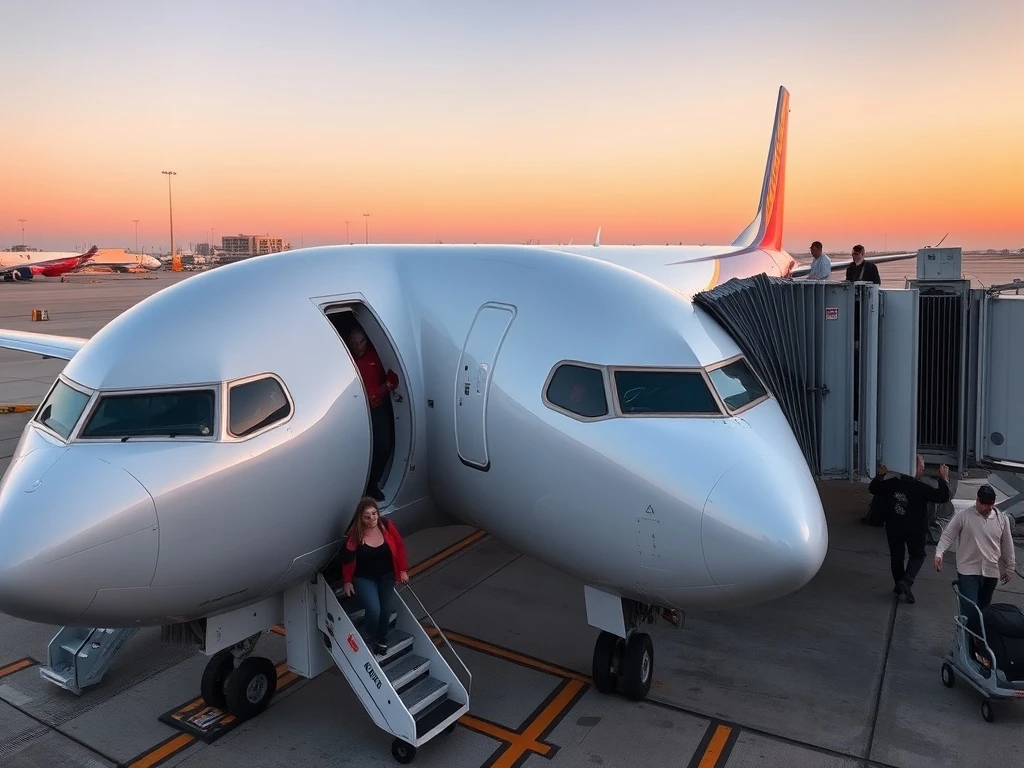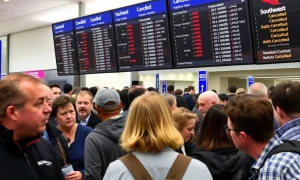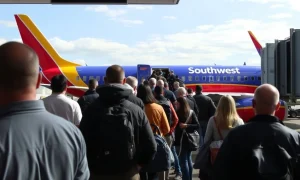For decades, Southwest Airlines stood apart in the competitive airline industry. It offered a unique proposition: no baggage fees, open seating, and a promise of simplicity. This model earned it the nickname, the ‘miracle in the sky’. However, recent announcements about the introduction of new Southwest Airlines fees signal a significant shift. This change marks the end of an era, transforming the airline’s long-held business strategy. Indeed, it also addresses underlying operational challenges.
The ‘Miracle in the Sky’: Southwest’s Legacy of Simplicity
Southwest Airlines built its reputation on a straightforward, no-frills approach. Founded in 1971, the airline championed low fares and customer-friendly policies. Consequently, passengers enjoyed benefits such as:
- Free checked bags: Two bags flew free, a stark contrast to other carriers.
- No change fees: Flexibility was a core promise, allowing passengers to alter plans without penalty.
- Open seating: This unique system allowed passengers to choose any available seat upon boarding.
- Consistent pricing: Fares were generally transparent, avoiding complex fee structures.
This model fostered immense customer loyalty. Many travelers appreciated the predictability and value. Moreover, it simplified the booking and travel process. Southwest became synonymous with affordable, hassle-free air travel. Therefore, it cultivated a distinct brand identity in a crowded market. The ‘miracle’ was its ability to maintain profitability while offering such generous terms. This strategy proved highly successful for many years. It allowed Southwest to grow significantly. The airline became a major player in domestic air travel. Its unique culture also contributed to its success.
Why the Shift? Unpacking the Drivers Behind New Southwest Airlines Fees
Despite its past success, the airline industry constantly evolves. Southwest faced increasing pressures from various fronts. Rising operational costs presented a significant challenge. Fuel prices fluctuate, and labor expenses continue to climb. Furthermore, intense competition from ultra-low-cost carriers (ULCCs) put pressure on Southwest’s fare structure. These airlines often charge for every conceivable extra. As a result, they can offer extremely low base fares. This creates a difficult competitive environment for Southwest. The ‘miracle in the sky’ model, while beloved, also presented certain limitations. It restricted the airline’s ability to generate additional revenue. Therefore, exploring new income streams became crucial. The introduction of Southwest Airlines fees addresses these growing financial and operational needs. It represents a strategic pivot. This pivot aims to secure the airline’s long-term profitability and competitiveness.
Specifically, the previous model created a ‘problem’ of missed revenue opportunities. Other airlines generated billions from ancillary services. Southwest, however, left this money on the table. The airline also faced challenges in managing passenger behavior. For instance, the free checked bag policy sometimes led to passengers bringing excessive luggage. This could slow down boarding and baggage handling. Similarly, the open seating model, while simple, did not allow for premium seat monetization. It also created a rush during boarding. Consequently, these factors contributed to operational inefficiencies. The new fee structure seeks to mitigate these issues. It aims to optimize revenue generation. It also intends to streamline operations. Ultimately, it allows Southwest to adapt to modern airline economics.
The Specifics of Emerging Southwest Airlines Fees
The precise details of the new fee structure are crucial for passengers. While Southwest has traditionally avoided many common charges, this is changing. Passengers should anticipate new costs for services once included. These changes reflect a broader industry trend. Airlines are increasingly relying on ancillary revenue. This means revenue from services beyond the basic fare. For instance, new Southwest Airlines fees might include:
- Preferred Boarding: A charge for early access to the plane. This allows passengers to secure better seats.
- Seat Selection: Fees for choosing specific seats in advance. This is common on other airlines.
- Additional Checked Baggage: While the first two bags might remain free, subsequent bags could incur a charge.
- In-flight Amenities: Charges for Wi-Fi access or premium entertainment options.
- Priority Security Access: Expedited screening at the airport, a common offering.
These fees aim to provide passengers with more choices. They also allow the airline to generate revenue from those choices. For example, a business traveler might pay for early boarding. A family might pay to select seats together. This unbundling of services allows for a more granular pricing model. It shifts the burden of cost to those who value specific services. Ultimately, this move brings Southwest more in line with industry norms. It allows the airline to compete on a new playing field. This strategy is expected to significantly boost the airline’s financial performance. It provides a new revenue stream for growth.
Impact on Passengers: A Changing Travel Experience
The introduction of new Southwest Airlines fees will undoubtedly alter the passenger experience. For loyal customers, this represents a departure from what they knew. The simplicity and predictability they valued may diminish. Passengers will now need to consider additional costs. This requires more careful planning when booking flights. The total cost of a trip could increase significantly. This depends on the services they choose. Budget-conscious travelers may feel the impact most acutely. They might find their overall travel expenses rising. However, there are also potential benefits for some travelers. The new fee structure offers more customization options. Passengers can choose to pay for services they value. They can opt out of services they do not need. This provides a level of control over their travel budget. For example, a light traveler might appreciate the lower base fare. They might not need extra services. Conversely, a traveler desiring specific amenities can now pay for them. The travel experience will become more segmented. It will cater to different preferences. This shift requires passengers to adjust their expectations. They must also adapt their travel habits. The airline aims to balance revenue generation with customer satisfaction.
Competitive Landscape: How Southwest Compares Now
With the introduction of new Southwest Airlines fees, the airline’s competitive positioning will change. Historically, Southwest stood out for its all-inclusive pricing. It offered a clear differentiator against legacy carriers like American, Delta, and United. These airlines have long relied on ancillary fees. They charge for checked bags, seat assignments, and other services. Similarly, ultra-low-cost carriers such as Spirit and Frontier have built their models around unbundled fares. Their base fares are often extremely low. However, they charge for nearly everything else. Southwest’s new approach places it closer to the middle ground. It will likely still offer some advantages over full-service carriers. For instance, it might retain its no-change-fee policy. Yet, it will also adopt some of the revenue strategies of its competitors. This move could intensify competition across the board. Other airlines might adjust their own strategies in response. They might seek new ways to differentiate themselves. Southwest’s brand loyalty will be tested. Its ability to retain customers while increasing prices is crucial. The market will closely watch how passengers react to these changes. The airline must clearly communicate the value proposition of its new offerings. It must also manage customer expectations effectively. The competitive landscape in air travel remains dynamic. Southwest’s move is a significant ripple in this market.
Operational Implications and the ‘Miracle’ Reimagined
The decision to implement new Southwest Airlines fees is not solely about revenue. It also carries significant operational implications. The previous ‘miracle’ model, while simple for customers, sometimes created operational challenges. For example, the open seating policy could lead to slower boarding times. Passengers would often rush to secure preferred seats. This caused congestion and delays. The free checked bag policy also contributed to baggage handling complexities. It increased the volume of luggage requiring processing. These factors could impact on-time performance. They also added to ground crew workload. The introduction of fees can help mitigate these issues. For instance, charging for preferred boarding or seat selection can incentivize passengers to board more efficiently. It can also monetize a previously unmonetized aspect of the boarding process. Similarly, fees for excessive baggage might encourage passengers to pack lighter. This could streamline baggage operations. It might also reduce weight on aircraft, potentially saving fuel. The ‘miracle in the sky’ is not ending entirely. Instead, it is being reimagined. Southwest aims to maintain its core values of friendly service and reliability. However, it will now do so within a more financially sustainable framework. This involves optimizing operations through strategic pricing. The goal is to enhance efficiency. It also seeks to improve the overall passenger flow. The airline is adapting its operational model. This adaptation ensures it remains competitive and robust for the future.
The Future of Southwest Airlines
The introduction of new Southwest Airlines fees marks a pivotal moment. It represents a significant strategic shift for the airline. The long-term effects of this change will unfold over time. Customer loyalty, a hallmark of Southwest, will be tested. Some passengers may feel betrayed by the departure from the no-fee model. Others might appreciate the new choices and the airline’s efforts to adapt. Southwest’s ability to communicate the value of these changes will be critical. It must explain how these fees enable continued investment in service and network expansion. The airline’s profitability is expected to improve. Ancillary revenue streams are a proven success for other carriers. This new income can fund fleet modernization and technological upgrades. It can also support employee benefits. However, Southwest must carefully manage its brand image. It needs to balance profitability with its unique customer-centric culture. The future of Southwest Airlines involves navigating this new landscape. It means evolving its service offerings. It also requires maintaining its distinct identity. The airline aims to remain a leader in domestic air travel. It will do so while embracing a more diversified revenue model. This evolution is necessary for sustained growth. It ensures the airline’s continued relevance in a dynamic industry.
In conclusion, the decision to implement new Southwest Airlines fees signifies a major transformation. It moves the airline away from its decades-old ‘miracle in the sky’ image. This shift addresses modern industry pressures. It also solves inherent challenges of the no-fee model. While some passengers may lament the change, it is a strategic necessity. Southwest is adapting to ensure its long-term viability. The airline seeks to maintain its competitive edge. It aims to secure its financial future. This evolution reflects a mature airline navigating a complex market. It also highlights the ongoing changes within the entire travel industry. The skies are changing, and Southwest is flying into a new era.
Frequently Asked Questions (FAQs)
Q1: Why is Southwest Airlines introducing new fees now?
Southwest Airlines is introducing new fees to address increasing operational costs and intense competition. This move also allows the airline to generate additional revenue. It helps monetize services previously offered for free. This aligns with broader industry trends.
Q2: What kinds of Southwest Airlines fees should passengers expect?
Passengers might expect fees for services like preferred boarding, specific seat selection, and potentially additional checked baggage beyond a certain limit. Other charges could include premium in-flight amenities such as Wi-Fi or entertainment. The exact fees will be detailed by the airline.
Q3: How will these new Southwest Airlines fees impact my travel costs?
Your travel costs could increase depending on the services you choose. If you opt for preferred boarding, specific seat assignments, or extra baggage, you will incur additional charges. However, if you stick to basic services, your base fare might remain competitive.
Q4: Does this mean the ‘miracle in the sky’ is completely over for Southwest?
The ‘miracle in the sky’ is evolving rather than ending completely. While Southwest is adding fees, it aims to retain its core values of customer service and flexibility, such as no change fees. The airline is adapting its business model to ensure long-term sustainability while maintaining its unique culture.
Q5: How will Southwest’s new fee structure compare to other airlines?
Southwest’s new fee structure will bring it more in line with legacy carriers and ultra-low-cost airlines. While it may not charge for every single item like some ULCCs, it will adopt common ancillary revenue strategies. This makes its pricing model more comparable across the industry.
Q6: Will the new fees improve Southwest’s operational efficiency?
Yes, the new fees are expected to improve operational efficiency. For instance, charges for preferred boarding or excessive baggage might encourage more streamlined passenger behavior. This could lead to faster boarding times and more efficient baggage handling. Ultimately, it contributes to better on-time performance.




















